Abstract
Background: Studying the effects of traffic vibration on adjacent structures has produced fruitful results, but there is a lack of systematic research on the protection, assessment, and ambient vibration effects on cultural relics, and the majority of the studies focus on above-ground buildings, with less research conducted on underground cultural relic sites. Objective: In order to investigate the effects of road-traffic-induced vibration on nearby underground sites, the distance between them was precisely determined. Methodology/approach: The site of Chengshang Village in Jurong City, Nanjing, China, was chosen as the research object, and the vibration of the underground site caused by traffic volume was measured on-site. Based on statistical analysis of experimental data, the vibration velocity was deduced as a function of the vehicle’s speed and the vibration source’s distance. Results: The excellent frequency band for traffic load vibration is between 0 and 40 Hz, and the attenuation speed of high-frequency vibration is faster than that of low-frequency vibration; the vibration speed is positively correlated with the speed of the vehicle, and the distance from the vibration source is exponentially attenuated; and under the condition of the determined limit value of the load and the vibration speed, the safety distance increases. Conclusions: This research utilizes the collected data to describe the relationship between the vibration velocity and the distance from the vibration source. Additionally, it estimates the appropriate distance at which cultural relics should be placed from the road to ensure their safety. The study’s findings may serve as a valuable point of reference for traffic planning and the preservation of underground cultural monuments.
1. Introduction
The ongoing urbanization process has led to significant advancements in transportation infrastructure, resulting in a steady increase in traffic volume. Consequently, the issue of road-traffic-induced vibrations affecting nearby cultural relics has become more pronounced. It is imperative to establish a scientific and rational method for assessing the extent of this impact and determining an appropriate safety distance between these two entities. Currently, vibration research in civil engineering is experiencing significant advancements. The primary focus of this research lies in investigating the environmental vibrations affecting buildings on the ground. The research primarily centers around two main areas: (1) the collection of vibration parameters and (2) the development of methods for analyzing vibration data. The studies focus on analyzing the vibrational response of a structure subjected to traffic-induced environmental pressures.
Initial research on vibration data collection and parameter analysis: Kouroussis et al. [1] proposed a combined experimental–numerical analysis method that anticipates the ground vibration level of a train traversing various railroad artifacts on the extant railroad network. Lombaert and Degrande [2] used numerical prediction to evaluate the non-uniformity-induced quasi-static and dynamic excitation of random trajectories. Lacanna et al. [3] demonstrated how to estimate the modal parameters of historic buildings using enhanced frequency domain decomposition (EFDD) in terms of intrinsic frequencies, damping ratios, and modal vibration shapes and, in a subsequent work, by combining modal analyses with seismic interferometry for the automated identification and real-time tracking of the building’s dynamic properties and their evaluation [4]. Lopes et al. [5] concentrated on the experimental substantiation of a numerical method previously proposed by the authors to predict internal building vibrations caused by railroad traffic in tunnels. Zini et al. [6] contrasted the efficiencies of the trapezoidal norm and the long discrete Fourier transform, and a systematic analysis of traffic-induced vibration phenomena using accelerometer data to identify dynamics was conducted. Chen et al. [7] obtained several ground vibration signals from experiments on railroad vibration and used magnitude analysis and wavelet packet analysis to determine the propagation law of track-induced vibration. Wang et al. [8] conducted an in-situ test along the Beijing–Shanghai High-speed Railway to determine the vertical, transverse, and longitudinal ground velocities and acceleration caused by high-speed trains.
Shi et al. [9] used vibration measurement data from a construction site of the Shenzhen Metro Line 1 as the premise for processing and analyzing the measured data using reasonable and comprehensive data processing techniques. Biao et al. [10] conducted on-site vibration experiments in a metro station beneath a high-speed railroad by installing accelerometers on the metro station’s sidewalls and the surrounding soil. Hinzen [11] provided examples of induced vibration measurements; analyzed the variability of signals from individual train segments, including test journeys at varying velocities; and compared critical portions of the railroad track before and after modifications. Tian et al. [12] conducted field experiments on the HAD High-Speed Railway in a frigid region to investigate the vertical acceleration. They analyzed the time and frequency domain characteristics of vertical acceleration based on the field data. Cai and Wang [13] examined the characteristics of ground vibration caused by rapid rail transit using the representative station in Nanjing as their research object. Ling et al. [14] investigated the vibration acceleration response of rails, sleepers, and embankment in the tundra test section of the Beilu River of the Qinghai–Tibet Railway by monitoring the vibration acceleration response of rails, sleepers, and embankment on-site, as well as the vibration response of rail traffic to track structure. The vibration response of railroad traffic to the track structure and its attenuation law were analyzed. Ling et al. [15] investigated the effect of the permafrost layer on the vibration response of embankment trains in winter and summer using acceleration time course and acceleration spectrum based on seasonal permafrost areas in Northeast China. Liu et al. [16] provided the intensity, frequency, and propagation characteristics of environmental vibration of transportation and analyzed the most influential environmental vibration problems in urban rail transport. Liu et al. [16] provided the intensity, frequency, and propagation characteristics of transportation environmental vibration, analyzed the primary influencing factors of urban rail transit, and summed up the current industry standards and evaluation procedures.
Numerous validated experimental, analytical methods have been proposed by researchers as a basis for evaluating the effects of environmental vibration-induced impacts on buildings, according to a review of the relevant literature.
Concerning the research on the impact of vibration caused by rail transit on buildings, the researchers focus primarily on the buildings surrounding the rail transit, analyze the effect of vibration caused by rail transit on buildings, and obtain the pertinent parameters for examining and evaluating the safety and integrity of the buildings. The current research outcomes in this field are more refined, using the extant modeling methods and analysis methods for finite element modeling of buildings and computational assessment of buildings. Jiang & Zhang [17] employed a combination of observational and theoretical techniques to investigate the actual situation, generation mechanism, and propagation of environmental vibration along the Pearl Line. He et al. [18] conducted a field experimental investigation of environmental vibration caused by a train. Field experiments were conducted to examine vibration. Roeck et al. [19] utilized the vibration signals of the Beijing Railway Transit Line 13 as inputs and calculated the responses for the 6-story, 10-story, and 16-story reinforced concrete and 5-story masonry structures. The environmental vibration outcomes were evaluated using Chinese and ISO standards. Hao et al. [20] conducted on-site measurements of indoor vibration and noise spectra of buildings near urban rapid transit lines in Tianjin, China, as an example to establish control criteria and evaluate the effectiveness of the corresponding mitigation measures. Liu et al. [21] studied reducing vibration caused by elevated tracks. They measured vibrations on the ground near an elevated light rail system under various soil conditions. They confirmed the validity of finite element analysis and proposed a rapid prediction method for ground vibration. Chen et al. [22] performed field measurements to assess the dynamic behavior of high-speed trains on bridges and the surrounding environment of the Wuhan–Guangzhou Passenger Dedicated Line. The findings indicate that the vibration response of the railroad environment satisfies the specified standards. Additionally, the environmental vibrations along the railroad were investigated. Zou et al. [23] conducted vibration and noise field measurements of subway train operation on the ground and adjacent three-story structures in a segment of subway rolling stock in Guangzhou, China. Liang & Gao [24] conducted measurements and analyses of environmental vibrations caused by the operation of freight trains near a typical Chinese low- and medium-speed rail line and the adjacent residential areas.
It was discovered that the theory and analysis path of environmental vibration impact of railroads on adjacent structures yielded remarkable results and that environmental vibration impact on ground cultural relic buildings was also assessed. The first environmental vibration impact on cultural antiquity buildings is rail transportation. Xia et al. [25] studied the dynamic response of the Beijing Liangxiang Pagoda of the Liao Dynasty to the action of trains on the Beijing–Guangzhou Railway. They assessed the safety and structural integrity of the pagoda based on the existing standards. Ma et al. [26] used the vibration effect of the Longhai Railway on the remnants of a grain silo as their research object. They obtained the vibration response of the granary ruins and the vibration attenuation effect of vibration isolation barriers through field testing. Li et al. [27] investigated the train vibration impact and dynamic characteristics of the Bodhi Pagoda in Beijing’s suburbs, which has a history of nearly one thousand years. Erkal et al. [28] conducted vibration measurements on the modest St. Sophia Mosque in Istanbul, which is situated near the Sirkeci–Halkali railroad line. There were vibration measurements taken. Multiple sites on the ground and in the building were used to record transmission-induced vibrations. The characteristics of attenuation on the ground and amplification on the building were investigated. Ma et al. [29] analyzed the vibration problems in the urban rail environment of the Round City and the Chengguangtang, two historical architectural complexes in Beijing. Using the two spatially contiguous tunnels in Xi’an as a study object, Ma et al. [30] investigated the influence of metro train vibration on the bell tower.
Most of the research on the environmental vibration effects of road traffic on historic structures is based on ambient vibration testing. Urushadze & Pirner [31] presented the measurement methods and results of the dynamic response of four historic structures to road traffic and other technological seismic activities. Pau and Vestroni [32] studied the influence of traffic vibration on the ambient vibration in the Basilica of Maxentius in Rome. Using the ambient vibration test, Altunişik et al. [33] analyzed the non-linear dynamic response of a historic masonry armory building to ambient vibration. Zonno et al. [34] presented the results of long-term environmental and structural tele-monitoring of two significant adobe chapels in southern Peru from the 16th century. The symbolic adobe temples of the 16th century are located in southern Peru. Ribilotta et al. [35] presented the preliminary findings of an environmental vibration study on the bell tower of San Ciriaco, Ancona, Italy. Ashayeri et al. [36] conducted environmental vibration experiments on eight historic Kermanshah mosques constructed in the 18th or 19th century A.D., for both the sites and the structures. Baraccani et al. [37] determined the impact of traffic-induced urban vibrations on the Bologna Twin Towers by preliminary data analysis from many dynamic monitoring campaigns conducted over the past few years. Costanzo et al. [38] investigated the influence of ambient vibration from traffic-induced vibrations at the Villa Farnesina in Rome.
Following a thorough examination of the literature, notable advancements have been achieved in research about the impact of vibrations induced by road traffic and other stresses on adjacent building structures. The findings of these papers may serve as sources of information for the study conducted in this article. Nevertheless, it is important to acknowledge that the study on environmental vibration in heritage conservation technology is now in the preliminary investigation phase. Road traffic vibration may cause fatigue damage to the common building structure of old structures, resulting in a decrease in their normal performance and a shortened fatigue life. Long-term vibrations may cause uneven soil settling, leading to irreparable damage or collapse of underground ruins or relics, which rely on the soil as their primary framework. Consequently, it is necessary to evaluate the impact of ambient vibrations on underground artifacts.
This study is centered on examining the effects of vibrations caused by road traffic on nearby subsurface sites, with a specific emphasis on the Chengshang Village site. An analysis was conducted on the vibration effects of road traffic on the Chengshang Village site using field tests. The study examined different aspects of the impact of road-traffic-induced vibrations on the underground site, including the patterns of vibration attenuation, measures for vibration damping and isolation, and the factors influencing these vibrations. The peculiarity of this research is that it uses the gathered data to delineate the correlation between vibration velocity and the distance from the vibration source. Additionally, it aims to determine the optimal distance between the artifacts and the road to guarantee the safety of the artifacts. The study’s findings may serve as a significant reference point for traffic planning and preserving underground cultural sites.
2. Heritage Profile and Vibration Control Standards
2.1. Heritage Overview
The Chengshang Village Site, situated in the southern part of Dazhuo Chengshang Village, Huayang Town, Jurong City, Zhenjiang City, Jiangsu Province, is an archaeological site that dates back to the Neolithic Age and extends until the Zhou Dynasty (1046 BC–256 BC). It holds significant historical importance as it served as a prominent city site for the Wu State during the Warring States Period (475 BC–221 BC). In May 2013, the State Council authorized and recognized it as the eighth group of national critical cultural relic preservation units. The site exhibits a significant cultural heritage, characterized by layers of compacted earth and surrounding moat structures. It covers a large area and has been well preserved, displaying a substantial accumulation of stratigraphic layers and abundant artifacts. The site extends longitudinally from north to south, with a shorter width from east to west, forming a slightly rectangular shape. The northern part of the site is elevated, standing approximately 7–8 m higher than the surrounding ground surface, while the southern part is comparatively lower. This site is exceptionally well preserved compared to others in Southern Jiangsu. The present plan is shown in Figure 1. The Chengshang Village site has significant academic value for the examination of Neolithic archaeological culture in the lower region of the Yangtze River, as well as the Hushu and Wu civilizations during the Shang and Zhou Dynasties.
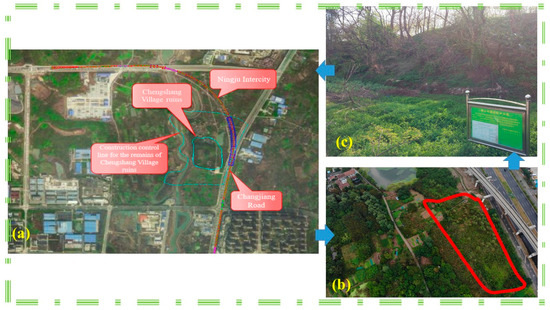
Figure 1.
Plane figure of Chengshang Village ruins. (a) An aerial photograph captured by a drone; (b) A red line delineating the location of Chengshang Village; and (c) Chinese signage bearing the inscription “Chengshang Village Site Protection Notice”.
The Hushu Culture is a prehistoric culture that existed in China’s southern region of the Yangtze River. It was named after its discovery in Hushu Street, Jiangning District, Nanjing City. Another related culture is the Hemudu Culture, which was mainly found in Nanjing, Zhenjiang, and the Taihu Lake Basin. These cultures represent the rich cultural heritage of the middle and lower reaches of the Yangtze River between 4000 and 5000 years ago. They hold the same significance as the central plains of the region. They date back to the period before the Shang Dynasty’s relocation to Yinxu.
Wu culture encompasses the cultural aspects, both tangible and intangible, that were developed by the inhabitants of Wu, a region located on the southeastern bank of the lower Yangtze River. This cultural heritage spans from the pre-Qin era to the Ming and Qing dynasties. From a geographical perspective, Wu culture is mostly found in present-day Jiangsu Province, Shanghai, and Zhejiang Province. It also extends to Jiangxi Province, Fujian Province, and a tiny portion of Anhui Province.
2.2. Ambient Vibration Source
The east side of the ruins is County Road 304, which is about 70 m away from the ruins’ protection line; its current plan is shown in Figure 1.
The cultural accumulation layer of Chengshang Village ruins is about 4 m thick, with an area of about 355 × 275 square meters, and is in a good state of preservation. More pottery pieces were excavated at the ruins, referring to the exploration data of the archaeological team; its stratigraphic accumulation is shown in Figure 2 and Table 1.

Figure 2.
Schematic diagram of stratigraphic accumulation of the Chengshang Village ruins.

Table 1.
Description of stratum accumulation.
2.3. Heritage Overview
The study object pertains to a cultural relic and specifically focuses on the issue of vibration impact rather than noise disturbance. Hence, the authors first provide the following standards about vibration control: GB/T 50452-2008 “Technical specifications for the protection of historic buildings against man-made vibration” provides technical guidelines for preventing industrial vibration in ancient buildings [38]. GB/T 14124-2009 “Mechanical vibration and shock—Vibration of buildings—Guidelines for measuring vibrations and evaluating their effects on buildings” outlines guidelines for measuring and evaluating the impact of mechanical vibration and shock on buildings [39].
Furthermore, the fundamental structural theme of the Chengshang Village site is mostly composed of soil materials, and there is currently no explicit regulation on the maximum allowable vibration velocity for underground sites. Considering the elastic wave velocity of the soil structure, which typically ranges from 90 to 500 m/s, and taking into account the Technical Specification for the Prevention of Industrial Vibration of Ancient Buildings (GB/T 50452-2008) [38] and relevant research findings [40,41,42], the maximum allowable horizontal vibration velocity at the Chengshang Village site is set at 0.15 mm/s.
3. Shock Vibration Field Test
3.1. Test Instruments
The vibration test system comprises a vibration transducer, a data gathering device, a computer, and other components. The data acquisition instrument utilizes the INV9580A wireless vibration collector from Beijing Oriental Institute of Vibration and Noise Technology. This collector is equipped with built-in horizontal and vertical dual-channel high-precision vibration pickups, allowing for dual-core 24-bit high-precision data acquisition. The instrument has a maximum sampling frequency of 256 Hz, with an error in frequency display and resolution of less than 0.01%. The vibration pickups have a sensitivity of 24 V−s/m and a range of 0.1 m/s. The data acquisition system comprises a computer that is used to conduct the vibration test. The vibrator has a sensitivity of 24 volts per second per meter and a range of 0.1 m per second.
3.2. Measurement Points Arrangement
In order to study the vibration response and attenuation law of the ground and the ruins, combined with the specific conditions of the test site, seven positions were selected between the Chengshang Village ruins and the travel lane, and vibration monitoring points were arranged on the ground surface, and one horizontal pickup was installed at each measuring point, and its X direction was perpendicular to the direction of the travel lane. The distances from the monitoring points to the travel lane are 2.5, 5.0, 10, 20, 35, 50, and 70 m, respectively, and the plane locations of the monitoring points are shown in Figure 3.
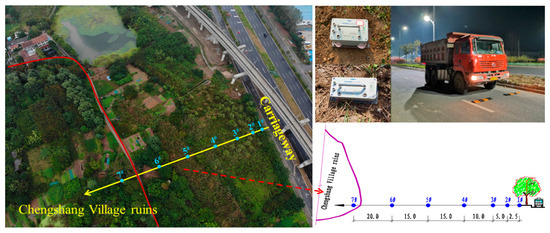
Figure 3.
Layout diagram of vibration measuring points.
3.3. Test Conditions
The field measurements were carried out late at night to avoid traffic disturbance. Considering the unfavorable conditions, a 30-ton heavy truck was used to drive through the traffic lane at different speeds, and the specific working conditions are shown in Table 2. Three types of data acquisition were carried out for each working condition, with an acquisition time of about 10 min. A 5 cm thick deceleration belt was arranged at the loading point to simulate the impact effect. The field vibration measurements are shown in Figure 3.

Table 2.
Test conditions.
4. Test Results and Analysis
4.1. Measurement Point Vibration Velocity Response
In order to explore the characteristics and propagation law of environmental vibration caused by traffic load at the Chengshang Village ruins, the peak vibration responses of each measuring point under different test conditions are shown in Table 3. It can be seen from Table 3 that the peak vibration response is positively correlated with travel speed; when the travel speed increases from 10 km/h to 60 km/h, the peak vibration response increases by 283% at 10 m away from the vibration source. The peak vibration response is inversely correlated with the distance from the vibration source, taking the travel speed of 10 km/h as an example. The peak vibration response decreases by 89.9% when the vibration source distance increases from 2.5 m to 70 m.

Table 3.
Test results of peak vibration response.
4.2. Hanger Appearance Inspection
Based on the test results in Table 3, there are significant differences in vibration intensity at different positions and travel speeds. The vibration intensity is more sensitive to the change in travel speed due to the influence of the “shock effect”. On the other hand, the energy density generated by vehicle vibration is attenuated during propagation, so the farther away from the vibration source, the smaller the vibration intensity of the measuring point.
Figure 4 gives each measuring point’s horizontal vibration velocity curves at different travel speeds. As shown in Figure 4, the vibration intensity caused by road traffic gradually attenuates with the increased distance from the vibration source. The vibration velocity attenuates extremely quickly at close range and then tends to be flattened when the distance exceeds 20 m. The influence of travel speed is mainly reflected at close range, while the travel speed has little effect for long-distance vibration.
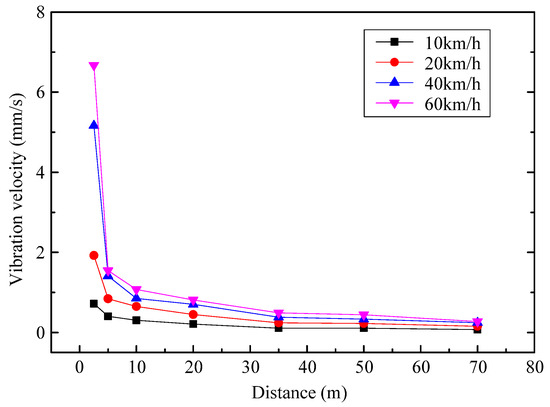
Figure 4.
The vibration response of different travel speeds.
It should be noted that the 70 m distance does not only consist of noise signals. The amplitude of vibration velocity at a distance of 70 m is 10−1 mm/s, but the vibration caused by noise typically ranges from 10(−2 to −3) mm/s. There is little association between the 70 m vibration velocity and the traveling speed. Nevertheless, the impact is minimal. Furthermore, the authors thoroughly reviewed the existing literature on environmental vibration, specifically focusing on the positioning of measurement sites. Surprisingly, no mention was found of the issue of noise at measurement points. For example, Yano et al. [43] measured noise after a sociological survey on Shinkansen noise. Noise levels were measured on many occasions at reference positions close to the Shinkansen line, along with distances of 5, 10, 20, 40, and 80 m from these reference points. Yokoshima et al. [44] gathered data at reference sites near the Shinkansen line at distances of 5, 10, 20, 40, and 80 m from these reference points. Wang et al. [45] placed observation locations at distances ranging from 15 m to 70 m from the centerline of the track, making use of the safety guardrails for protection. Zhang & Ma [46] performed vibration measurements to address the issues of environmental vibration and environmental noise pollution. The noise levels of passing railroad trains were recorded at distances of 0, 10, 20, 40, 80, and 160 m from the reference location.
The time-history curves of the ground vibration response of each measuring point at different travel speeds are shown in Figure 5.

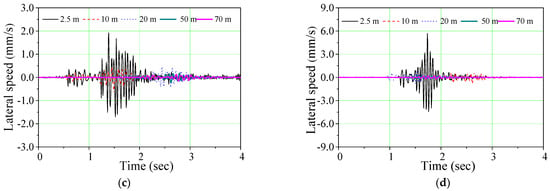
Figure 5.
Time-history curves of vibration response at different points. (a) Travel speed 10 km/h; (b) Travel speed 20 km/h; (c) Travel speed 40 km/h; (d) Travel speed 60 km/h.
As seen in Figure 5, for the same travel speed, the horizontal vibration velocity response decreases with the increase of the vibration source distance. In addition, due to the time-sensitive vibration propagation, there is an obvious “vibration hysteresis” phenomenon for long-distance vibration. Heavy vehicles should slow down as much as possible and keep away from cultural relics in actual projects.
4.3. Hanger Overall Static Load Test
The horizontal vibration velocity spectra of monitoring points at different travel speeds are shown in Figure 6.
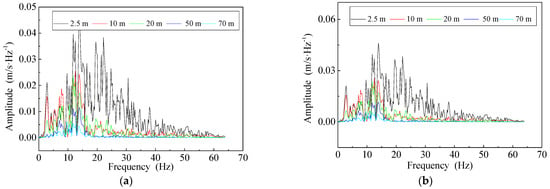
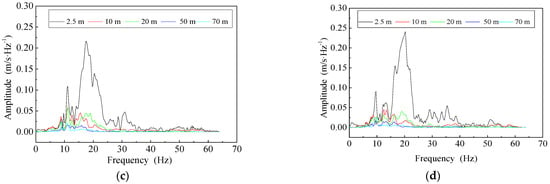
Figure 6.
Vibration velocity spectrum response at different travel speeds. (a) Travel speed 10 km/h; (b) Travel speed 20 km/h; (c) Travel speed 40 km/h; (d) Travel speed 60 km/h.
As can be seen from Figure 6, the excellent frequency band of the vibration velocity spectrum is distributed at 0~40 Hz. When the travel speed is low, there are two main frequencies near 10 Hz and 20 Hz. With the increase in travel speed, the vibration frequency band of 20 Hz is gradually significant. For the location far from the vibration source, the vibration intensity of each frequency decreases with the increase of distance, and the decay speed of high-frequency vibration is significantly higher than that of low-frequency vibration. The horizontal vibration velocity of the monitoring point is dominated by low-frequency vibration within 20 Hz.
4.4. Vibration Attenuation Law and Safety Distance Calculation
According to the existing research theories [8,9,10], vibration attenuation is affected by the dual effects of wavefront geometrical diffusion and medium absorption. In actual engineering, the formation is not an ideal linear elastic medium, during the vibration transmission process, the formation absorbs part of the vibration energy, resulting in the vibration energy in the form of exponential decay. On the other hand, the excitation of the vibration source is related to the travel speed diffused in the horizontal direction, with the increase of the propagation distance, its energy density decays according to the power function law.
Based on previous research findings, it has been observed that the vibration velocity decreases exponentially as the distance from the vibration source increases [47]. Additionally, the vibration velocity increases as the vehicle speed increases, following a power function [48]. Therefore, a mathematical equation Equation (1) can be formulated to represent the relationship between vibration velocity and distance from the vibration source. Notably, the findings supporting Equation (1) have been validated by the author’s team in environmental vibration studies and analogous investigations.
Here, is the surface vibration velocity; is the distance of the measuring point from the vibration source; is the travel speed; is the equivalent coefficient, which is related to the impact energy and site medium conditions; is the index related to the travel speed; is the geometric damping attenuation coefficient; and is the energy absorption coefficient of the soil, which is related to the engineering properties of the soil.
To confirm the suitability and precision of Equation (1), the collected data from various vehicle speeds at the Chengshang Village site were subjected to fitting and analysis. Specifically, Equation (1) was input into the origin software to determine its functional form, and the parameter values were obtained as follows: k = 0.152, a = 0.74, b = 0.338, and c = 0.015. R2 represents the variance of the fit. Figure 7 displays the attenuation curves of vibration velocity as a function of distance from the vibration source for various vehicle speeds.

Figure 7.
Decay relationships between vibration velocity and distance. (a) Travel speed 10 km/h; (b) Travel speed 20 km/h; (c) Travel speed 40 km/h; (d) Travel speed 60 km/h.
As can be seen from Figure 7, the attenuation of surface vibration intensity is in good agreement with the field-measured data, indicating that Equation (1) can better describe the propagation law of traffic load vibration, and the specific functional relationship can be expressed as follows.
Referring to the “Technical specifications for protection of historic buildings against man-made vibration“ (GB/T 50452-2008) and the research results of related literature [38], the critical value of the vibration velocity is taken as 0.15 mm/s. For a given travel speed, the safety distance can be back-calculated by Equation (2), and the calculation results are shown in Table 4.

Table 4.
Calculation of safety distance under various conditions.
From the calculation results in Table 4, it can be seen that with the increase in travel speed, the safety distance also increases, and the safety distance is positively correlated with the travel speed. The safe area of cultural relics can be drawn by fitting curves, as shown in Figure 8.
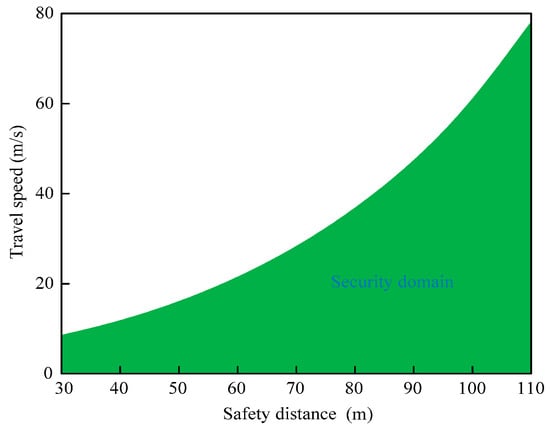
Figure 8.
Safe area determined by driving speed and safe distance.
5. Similar Studies
The author’s team is currently investigating the “Impact of road traffic-induced vibration on the neighboring underground sites” (illustrated in Figure 9), in addition to the cultural relics and sites of Chengshang Village. They are also involved in the following projects: The Nanjing Mufu Mountain Ancient Tomb Group is a nationally recognized cultural heritage site under protection. Mufu is a mountain range on the Yangtze River’s southern bank. It has served as a significant obstacle and strategic position in the northern outskirts of Nanjing since ancient times. Additionally, it has been a prominent region for burial sites since the Six Dynasties era (222–589 A.D.), which encompasses the six dynasties in the southern part of Chinese history from the Three Kingdoms to the Sui Dynasty. The YiJia Historic Relics, which spans around 1897 m2, is a Hushu cultural heritage site component.
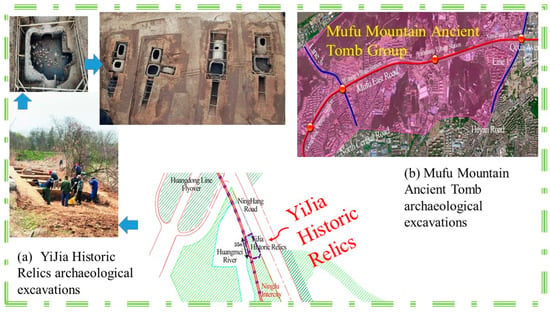
Figure 9.
Similar studies.
The authors will use the findings from road traffic vibration measurements conducted at the Chengsang Village site to examine the impact of traffic vibration on cultural artifacts. They want to enhance the preservation of cultural relics and structures by using the on-site data obtained. Subsequent findings will be disclosed at a later time.
6. Conclusions
The following conclusions were obtained through a field test study on the vibration of a 30-ton heavy truck passing over a speed bump and analyzing the vibration and propagation laws caused by different travel speeds at different positions.
- (1)
- The change law of vibration velocity response with the distance of vibration source is similar under different travel speeds. With the increase of vibration source distance, the vibration response decays exponentially, and the vibration velocity increases with the increase of travel speed, showing a power function relationship overall.
- (2)
- The superior frequency band of the vibration response caused by passing the speed bump is 0–40 Hz, and the primary frequency of the truck vibration is 20 Hz. The vibration response of each frequency band decreases with the increase of the vibration source distance. The decay rate of the high-frequency vibration is significantly higher than that of the low-frequency vibration.
- (3)
- Combined with the experimental monitoring data, the general functional relationship of vibration intensity with travel speed and vibration source distance is established. The empirical parameters of the impact of travel speed on the vibration of adjacent underground cultural relics are obtained. This research can predict the vibration of underground cultural relics, which has specific significance for protecting underground cultural relics.
- (4)
- Indeed, regarding the effect on historic structures, road traffic vibration surpasses subway vibration and proves to be more challenging to manage. Integrating micro-vibration control techniques in historic buildings should be accompanied by strategies like minimizing road traffic and expanding the buffer zone between buildings and roads.
7. Limitations and Future Research
The research has several limitations, which are as follows:
- (1)
- The study lacks modeling and theoretical analysis, focusing only on field in-situ tests.
- (2)
- The test findings only consider the surface vibration response without investigating the vibration attenuation pattern at different depths.
The present study, namely the law of vibration effect, is a fundamental piece of research. Based on this premise, the tasks to be undertaken encompass the following:
- (1)
- Micro-vibration control is crucial for safeguarding cultural artifacts and structures. The effects of vibration on these entities can compromise both their safety and integrity. Therefore, it is imperative to develop a method for assessing the susceptibility of cultural artifacts or sites to micro-vibrations.
- (2)
- Maintenance has a beneficial impact on enhancing the ability of structures to withstand vibrations, particularly for cultural relics made of earth blocks classified as “cultural sites or relics.” It is necessary to implement suitable reinforcing measures for these relics.
- (3)
- Development of vibration standards for “earth-block cultural artifacts”.
Author Contributions
Conceptualization, L.Z., J.M. and L.C.; methodology, L.C.; software, L.C.; validation, L.C.; formal analysis, X.H.; resources, L.C.; data curation, X.H.; writing—original draft preparation, L.Z. and J.M.; writing—review and editing, L.Z., J.M., L.C. and X.H.; visualization, X.H.; supervision, L.C.; project administration, L.Z., J.M. and L.C.; funding acquisition, L.C.; All authors have read and agreed to the published version of the manuscript.
Funding
This paper is part of the research work of the National Key R&D Project of China Grant Nos. 2021YFB2600602 and 2021YFB2600600. The authors would like to gratefully acknowledge the support for this research by the Yangzhou Key R&D Program (Social Development) Grant No. YZ2023077.
Institutional Review Board Statement
Not applicable.
Informed Consent Statement
Not applicable.
Data Availability Statement
Some or all data, models, or codes that support the findings of this study are available from the corresponding author upon reasonable request.
Acknowledgments
The corresponding author thanks the 2018 Jiangsu Provincial Government Scholarship Program (No. 228) for supporting his visit to the University of California, Los Angeles. Special thanks to Yanming Chen, Sen Zhang, Cheng Huan and Qingyun Miao for their valuable advice to this work.
Conflicts of Interest
Author Jiang Meng was employed by the company NJTech Bridge & Tunnel and Rail Transit Institute; the remaining authors declare that the research was conducted in the absence of any commercial or financial relationships that could be construed as a potential conflict of interest. Author Lingkun Chen was employed by the company Transportation Science Institute of Nanjing University of Technology (Chuzhou) Co., Ltd.; the remaining authors declare that the research was conducted in the absence of any commercial or financial relationships that could be construed as a potential conflict of interest.
References
- Kouroussis, G.; Vogiatzis, K.E.; Connolly, D.P. A combined numerical/experimental prediction method for urban railway vibration. Soil Dyn. Earthq. Eng. 2017, 97, 377–386. [Google Scholar] [CrossRef]
- Lombaert, G.; Degrande, G. Ground-borne vibration due to static and dynamic axle loads of InterCity and high-speed trains. J. Sound Vib. 2009, 319, 1036–1066. [Google Scholar] [CrossRef]
- Lacanna, G.; Ripepe, M.; Marchetti, E.; Coli, M.; Garzonio, C.A. Dynamic response of the Baptistery of San Giovanni in Florence, Italy, based on ambient vibration test. J. Cult. Herit. 2016, 20, 632–640. [Google Scholar] [CrossRef]
- Lacanna, G.; Ripepe, M.; Coli, M.; Genco, R.; Marchetti, E. Full structural dynamic response from ambient vibration of Giotto’s bell tower in Firenze (Italy), using modal analysis and seismic interferometry. NDT E Int. 2019, 102, 9–15. [Google Scholar] [CrossRef]
- Lopes, P.; Ruiz, J.F.; Costa, P.A.; Rodríguez, L.M.; Cardoso, A.S. Vibrations inside buildings due to subway railway traffic. Experimental validation of a comprehensive prediction model. Sci. Total Environ. 2016, 568, 1333–1343. [Google Scholar] [CrossRef] [PubMed]
- Zini, G.; Betti, M.; Bartoli, G. Experimental analysis of the traffic-induced-vibration on an ancient lodge. Struct. Control. Health Monit. 2022, 29, e2900. [Google Scholar] [CrossRef]
- Chen, S.H.; Qi, G.F.; Bi, W.G.; Gao, W.L. Experimental study on vibration propagation of rail transport. Appl. Mech. Mater. 2011, 90, 453–456. [Google Scholar] [CrossRef]
- Wang, P.; Wei, K.; Wang, L.; Xiao, J. Experimental study of the frequency-domain characteristics of ground vibrations caused by a high-speed train running on non-ballasted track. Proc. Inst. Mech. Eng. Part F J. Rail Rapid Transit 2016, 230, 1131–1144. [Google Scholar] [CrossRef]
- Shi, W.; Bai, L.; Han, J. Subway-induced vibration measurement and evaluation of the structure on a construction site at curved section of metro line. Shock Vib. 2018, 2018, 5763101. [Google Scholar] [CrossRef]
- Biao, Z.; Fengshou, Z.; Xiongyao, X. Vibration characteristics of underground structure and surrounding soil underneath high speed railway based on field vibration tests. Shock Vib. 2018, 2018, 3526952. [Google Scholar]
- Hinzen, K.G. Subway-induced vibrations in cologne cathedral. Seismol. Res. Lett. 2014, 85, 631–638. [Google Scholar] [CrossRef]
- Tian, S.; Tang, L.; Ling, X.; Ye, Y.; Wang, W. Field investigation into the vibration characteristics at the embankment of ballastless tracks induced by high-speed trains in frozen regions. Soil Dyn. Earthq. Eng. 2020, 139, 106387. [Google Scholar] [CrossRef]
- Cai, Y.; Wang, J. Modeling of Stress-Strain Behavior of Soft Clay under Cyclic Loading; Springer: Berlin/Heidelberg, Germany, 2008. [Google Scholar]
- Ling, X.Z.; Chen, S.J.; Zhu, Z.Y.; Zhang, F.; Wang, L.N.; Zou, Z.Y. Field monitoring on the train-induced vibration response of track structure in the beiluhe permafrost region along qinghai–tibet railway in china. Cold Reg. Sci. Technol. 2010, 60, 75–83. [Google Scholar] [CrossRef]
- Ling, X.Z.; Wang, L.N.; Zhang, F.; Chen, S.J.; Zhu, Z.Y. Field experiment on train-induced embankment vibration responses in seasonally-frozen regions of Daqing, China. J. Zhejiang Univ.-Sci. A 2010, 11, 596–605. [Google Scholar] [CrossRef]
- Meng, M.; Weifeng, L. Overview on current research of environmental vibration influence induced by urban mass transit in China. Sci. Sin. Technol. 2016, 46, 547–559. [Google Scholar]
- Jiang, T.; Zhang, X. In situ experiments and numerical assessment of environmental vibration induced by urban viaduct rail transit in Shanghai. In Proceedings of the 13th World Conference on Earthquake Engineering, Vancouver, BC, Canada, 1–6 August 2004; pp. 1–11. [Google Scholar]
- Xia, H.; Chen, J.; Wei, P.; Xia, C.; De Roeck, G.; Degrande, G. Experimental investigation of railway train-induced vibrations of surrounding ground and a nearby multi-story building. Earthq. Eng. Eng. Vib. 2009, 8, 137–148. [Google Scholar] [CrossRef]
- De Roeck, G.; Degrande, G.; Lombaert, G.; Müller, G. Study on Environmental Vibration Induced by Urban Rail Transit in Urban Area of the Near Buildings. In Proceedings of the 8th International Conference on Structural Dynamics, EURODYN 2011, Leuven, Belgium, 4–6 July 2011. [Google Scholar]
- Hao, Y.; Qi, H.; Liu, S.; Nian, V.; Zhang, Z.; Li, M.E. Study of Noise and Vibration Impacts to Buildings Due to Urban Rail Transit and Mitigation Measures. Sustainability 2022, 14, 31192022. [Google Scholar] [CrossRef]
- Liu, C.; Zhou, Y.; Tu, Y.; Xu, W. Study on elevated light rail induced vibration attenuation along the surrounding ground. In Proceedings of the Internoise 2014, Melbourne, VIC, Australia, 16–19 November 2014. [Google Scholar]
- Jian-guo, C.; Tong-yin, H.; Xiu-mei, Y.; Yan-mei, C. Experiment study on dynamic responses of bridge and surrounding environment induced by high-speed trains. In Proceedings of the 2010 WASE International Conference on Information Engineering, Beidai, China, 14–15 August 2010; Volume 3, pp. 270–274. [Google Scholar]
- Zou, C.; Wang, Y.; Wang, P.; Guo, J. Measurement of ground and nearby building vibration and noise induced by trains in a metro depot. Sci. Total Environ. 2015, 536, 761–773. [Google Scholar] [CrossRef]
- Sun, C.; Gao, L. Medium-to-low-speed freight rail transport induced environmental vibration and analysis of the vibration isolation effect of building slope protection piles. J. Vibroeng. 2017, 19, 4531–4549. [Google Scholar] [CrossRef][Green Version]
- Xia, Q.; Zhao, J.; Wang, D.; Li, Y. Analysis of dynamic response and fatigue life of masonry pagoda under the influence of train vibration. Adv. Civ. Eng. 2020, 2020 Pt 18, 7236310. [Google Scholar] [CrossRef]
- Ma, Q.; Li, X.; Cheng, C.; Yan, H. Field measurement, analysis and protection for the vibration response of granary ruins caused by train load. IOP Conf. Ser. Earth Environ. Sci. 2021, 676, 012126. [Google Scholar] [CrossRef]
- Li, M.; Ma, M.; Cao, Z.; Xia, Q.; Liu, W. Dynamic response analysis of train-induced vibration impact on the probhutaratna pagoda in beijing. Earthq. Eng. Eng. Vib. 2021, 20, 223–243. [Google Scholar] [CrossRef]
- Erkal, A.; Laefer, D.; Fanning, P.; Durukal, E.; Hancilar, U.; Kaya, Y. Investigation of the rail-induced vibrations on a masonry historical building. Adv. Mater. Res. 2010, 133–134, 569–574. [Google Scholar] [CrossRef]
- Ma, M.; Cao, Y.; Sun, X.; Liu, W. Prediction of Metro Train-Induced Vibrations on a Historic Building: The Case of the Round City and Chengguang Hall in Beijing; Springer: Cham, Switzerland, 2017. [Google Scholar]
- Ma, M.; Liu, W.; Qian, C.; Deng, G.; Li, Y. Study of the train-induced vibration impact on a historic Bell Tower above two spatially overlapping metro lines. Soil Dyn. Earthq. Eng. 2016, 81, 58–74. [Google Scholar] [CrossRef]
- Urushadze, S.; Pirner, M. Analysis and evaluation of the effect of vibrations on historical buildings. MATEC Web Conf. 2020, 313, 00020. [Google Scholar] [CrossRef][Green Version]
- Pau, A.; Vestroni, F. Vibration assessment and structural monitoring of the basilica of maxentius in rome. Mech. Syst. Signal Process. 2013, 41, 454–466. [Google Scholar] [CrossRef]
- Altunisik, A.C.; Genc, A.F.; Gunaydin, M.; Okur, F.Y.; Karahasan, O.S. Dynamic response of a historical armory building using the finite element model validated by the ambient vibration test. J. Vib. Control 2018, 24, 5472–5484. [Google Scholar] [CrossRef]
- Zonno, G.; Aguilar, R.; Boroschek, R.; Loureno, P.B. Environmental and ambient vibration monitoring of historical adobe buildings: Applications in emblematic andean churches. Int. J. Archit. Herit. 2019, 15, 1113–1129. [Google Scholar] [CrossRef]
- Ribilotta, E.; Clementi, F.; Pellegrino, M.; Poiani, M.; Gazzani, V.; Santilli, G.; Lenci, S. Monitoring Cultural Heritage Buildings: The San Ciriaco Bell-Tower in Ancona. In Proceedings of the 14th International Conference of Computational Methods in Sciences and Engineering, Thessaloniki, Greece, 14–18 March 2018. [Google Scholar]
- Ashayeri, I.; Biglari, M.; Formisano, A.; D’Amato, M. Ambient vibration testing and empirical relation for natural period of historical mosques. case study of eight mosques in kermanshah, iran. Constr. Build. Mater. 2021, 289, 123191. [Google Scholar] [CrossRef]
- Baraccani, S.; Azzara, R.M.; Palermo, M.; Gasparini, G.; Trombetti, T. Long-term seismometric monitoring of the two towers of bologna (Italy): Modal frequencies identification and effects due to traffic induced vibrations. Front. Built Environ. 2020, 6, 85. [Google Scholar] [CrossRef]
- GB/T 50452; Technical Specifications for Protection of Historic Buildings against Man-Made Vibration. Architecture & Building Press: Beijing, China, 2008.
- GB/T 14124-2009/ISO 4866: 1990; Mechanical Vibration and Shock—Vibration of Buildings—Guidelines for the Measurement of Vibrations and Evaluation of Their Effects on Buildings. China Standard Press: Beijing, China, 2009.
- Turunen-Rise, I.H.; Brekke, A.; Hårvik, L.; Madshus, C.; Klæboe, R. Vibration in dwellings from road and rail traffic—Part I: A new Norwegian measurement standard and classification system. Appl. Acoust. 2003, 64, 71–87. [Google Scholar] [CrossRef]
- Pyl, L.; Degrande, G.; Clouteau, D. Validation of a source–receiver model for road traffic-induced vibrations in buildings. II: Receiver model. J. Eng. Mech. 2004, 130, 1394–1406. [Google Scholar] [CrossRef]
- Mhanna, M.; Sadek, M.; Shahrour, I. Prediction and mitigation of traffic induced ground vibrations in an urban zone. WIT Trans. Built Environ. 2011, 116, 701–711. [Google Scholar]
- Yano, T.; Morihara, T.; Sato, T. Community response to Shinkansen noise and vibration: A survey in areas along the Sanyo Shinkansen Line. In Proceedings of the Forum Acusticum, Budapest, Hungary, 30 August–2 September 2005; pp. 1837–1841. [Google Scholar]
- Yokoshima, S.; Morihara, T.; Ota, A.; Tamura, A. Reanalysis of dose-response curves of Shinkansen railway noise. In Proceedings of the 9th International Congress on Noise as a Public Health Problem (ICBEN), Foxwoods, CT, USA, 21–25 July 2008. [Google Scholar]
- Wang, Z.; Tang, A.; Huang, D.; Wu, C.; Huang, Z. A novel environmental vibration analysis system and its application in isolation of environmental vibration induced by high-speed train in Harbin frozen soil site. Appl. Acoust. 2022, 193, 108781. [Google Scholar] [CrossRef]
- Zhang, L.; Ma, H. Investigation of Chinese residents’ community response to high-speed railway noise. Appl. Acoust. 2021, 172, 107615. [Google Scholar] [CrossRef]
- Gazetas, G. Vibrational characteristics of soil deposits with variable wave velocity. Int. J. Numer. Anal. Methods Geomech. 1982, 6, 1–20. [Google Scholar] [CrossRef]
- Takemiya, H. Field vibration mitigation by honeycomb WIB for pile foundations of a high-speed train viaduct. Soil Dyn. Earthq. Eng. 2004, 24, 69–87. [Google Scholar] [CrossRef]
Disclaimer/Publisher’s Note: The statements, opinions and data contained in all publications are solely those of the individual author(s) and contributor(s) and not of MDPI and/or the editor(s). MDPI and/or the editor(s) disclaim responsibility for any injury to people or property resulting from any ideas, methods, instructions or products referred to in the content. |
© 2023 by the authors. Licensee MDPI, Basel, Switzerland. This article is an open access article distributed under the terms and conditions of the Creative Commons Attribution (CC BY) license (https://creativecommons.org/licenses/by/4.0/).